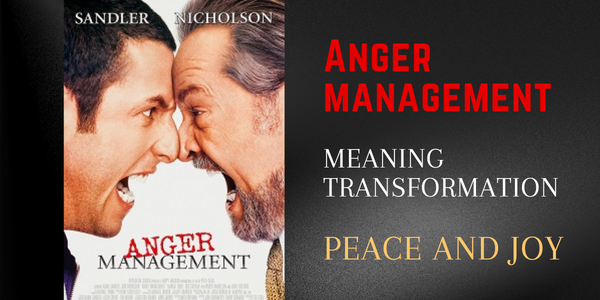“I am very angry. God knows that I try, but I can’t help it – I have every reason to be mad” (Segal, 2003). If this sentiment sounds familiar, it is because all of us have experienced similar inner struggles with respect to anger.
Why are We Angry?
- Wouldn’t you be angry if what you have built with sweat and blood is snatched away from you by force and handed over to someone else?
- Wouldn’t you be furious when your trusted friend stabs you in the back and turns against you?
- Wouldn’t you be filled with righteous indignation when religious leaders abuse their subordinates spiritually and psychologically, all in God’s name?
- Wouldn’t you be filled with rage and pain if your house was destroyed and your family killed by a bombing?
- Wouldn’t you be mad if you were arrested, imprisoned, and interrogated for no other reason than your ethnic-racial background?
- Wouldn’t you be fuming if your country was occupied and your freedom and rights were taken away from you?
- Wouldn’t you be furious if you were dismissed in spite of your many years of contribution, whereas your incompetent and lazy co-worker was promoted simply because he was related to the boss?
There are enough legitimate reasons to make people burn with righteous anger all the time, e.g., abuse of power, corruption, hypocrisy, poverty, deprivation, inequality, injustice, senseless wars, violence, atrocities, terrorism, oppression, humiliation, betrayal, discrimination, and mistreatments.
Of course, people can also get angry over trivial matters, e.g., a thoughtless remark, being slighted, failing to get proper respect, misunderstanding, and petty jealousy. Sometimes even the slightest provocation can set off an outburst.We are also a nation of angry people and we are becoming an increasingly angry society. We live in a world filled with enough anger and hate to blow it to pieces. Everyone seems to be angry with someone for some reason. Many have acted out their anger. Terrorist bombings are simply the extreme expression of anger.
The above introduction to anger management was written by Wong (2003) just a few months after the movie Anger Management (Segal, 2003) was released. My introduction to anger management is as relevant today as when it was first written.
To repeat, we are a nation of angry people, and we are becoming an increasingly angry society. “Why does everyone seem so angry all of a sudden?” asks Henry Ford Health Staff (2022). They proceed to answer their own question as follows:
It’s a sign of our distress and an example of our suffering. We have all experienced social isolation, a loss of routine, increased fear and prolonged uncertainty, grief and loss—even grieving the way things used to be. Anger in the short term is normal, understandable and even adaptive. It can signal to us that something is wrong and needs to be addressed. (para. 2)
How do We Manage our Anger?
How do you cope with angry feelings? How do you respond to all the people and situations that make us mad? It is often said that you either control your anger or anger controls you.
No one wants anger to be their master and ruin their lives. Therefore, it is important that we learn how to be in control of our anger, which can be one of the most explosive and destructive emotions.
Therefore, some people are ordered to take anger management classes for their violent behaviors. There are all kinds of anger management programs, as there are different approaches. Typically, they include both preventive and reactive measures.
Preventive measures include common sense ways of healthy living such as having enough sleep, eating a good diet, and avoiding burnout or too much stress. Reaction measures include cognitive restructuring, relaxation, humor, and exercise (American Psychological Association, 2022; Mayo Clinic Staff, 2022).
However, these measures are often inadequate in dealing with long-term or traumatic situations, such as a toxic marriage, abusive parenting, rape, murder, and various kinds of violence against a person. I propose that meaning therapy (Wong, 2010, 2016) may be more helpful. In the last section of this essay, I will briefly describe the three strategies of meaning transformation of anger into peace and joy.
How to Transform Anger to Peace and Joy

There are three flexible and practical strategies based on meaning therapy:
The Initial Attributional Search
This represents the important pause between the triggering event and our reaction (Wong, 2020). During this brief pause, we ask ourselves three basic questions:
- What is happening?– We need to observe clearly so make sure that we don’t jump to conclusions based on incomplete information. This will avoid a lot of unnecessary misunderstanding and angry reactions.
- What does it mean? We need to consult our forebrain to find out the true meaning of the situation to avoid reacting based on our biases and assumptions (Wong & Weiner, 1981).
- What is the right thing to do? We also need to consult our conscience and divine guidance for the correct response for that situation.
A Deep Attributional Search
In complex or ambiguous situations, we may need a deeper and more thorough attribution search. For example, in order to find out the real reasons for some offending action, we may need to seek deeper beyond the other person’s facades, manners, attitudes, and habits by searching deeper inside. We may discover a wounded, scared, and lost soul, struggling with their loneliness and private hell. With compassion and empathy, we may feel sorry rather than angry towards that person. Further, we may find hidden situational reasons for their offensive behavior. For example, they may have behaved offensively because of pressure from their spouse.
The Deep-and-Wide Hypothesis
This hypothesis (Wong & Worth, 2017) is based on Wong ‘s stage model of coping with frustration (Wong, 1995) which describes the innate behavior mechanisms of prolonged frustration stress:
- The first stage is same as Amsel’s frustration-invigoration effect. The first natural reaction is trying harder, which may include aggression as suggested by the frustration-aggression hypothesis (Dollard et al., 1939). One needs to guard against the more primitive tendency to fight back verbally or physically. The essence is to due the same thing with greater effort and precision.
- The second stage is trying different ways of solving the problem. It really challenges one’s resourcefulness, creativity, and perseverance. This is the most important stage because successful resolution depends on how far and how wide one searches for a peaceful solution.
- The third stage is switching to a different goal. It is more adaptive at some point to give up the futile effort of seeking the same goal of finding reconciliation or successful resolution and settle for plan B instead.
- The last stage is helplessness and depression or patiently enduring a toxic relationship or situation. At this stage, one may need divine grace or supernatural power to endure the Sisyphus struggle joyfully.
In conclusion, I do hope that my meaning transformation perspective is helpful to you, whatever your predicament. I also wish my readers a happy and peaceful Christmas and New Year in spite of the turbulent time our world is in. May next year be a more peaceful year without the Russian rockets landing in Ukraine, and without all the military threats from China towards Taiwan. Let us all try to find ways to live together in peace. As Martin Luther King Jr. has warned us, “We must learn to live together as brothers or perish together as fools.”
References
- American Psychological Association. (2022, August 9). Control anger before it controls you. https://www.apa.org/topics/anger/control
- Dollard, J., Miller, N. E., Doob, L. W., Mowrer, O. H., & Sears, R. R. (1939). Frustration and aggression. Yale University Press. https://doi.org/10.1037/10022-000
- Henry Ford Health Staff. (2022, April 26). Why does everyone seem so angry all of a sudden? Henry Ford Health. https://www.henryford.com/blog/2022/04/pandemic-rage
- Mayo Clinic Staff. (2022, April 14). Anger management: 10 tips to tame your temper. Mayo Clinic. https://www.mayoclinic.org/healthy-lifestyle/adult-health/in-depth/anger-management/art-20045434
- Segal, P. (Director). (2003). Anger management [Film]. Sony Pictures Releasing.
- Wong, P. T. P. (1995). A stage model of coping with frustrative stress. In R. Wong (Ed.), Biological perspectives on motivated activities (pp. 339–378). Ablex Publishing.
- Wong, P. T. P. (2003). From anger management to anger transformation. International Network on Personal Meaning. http://www.meaning.ca/archives/archive/art_anger-transformation_P_Wong.htm
- Wong, P. T. P. (2010). Meaning therapy: An integrative and positive existential psychology. Journal of Contemporary Psychotherapy, 40(2), 85-99.
- Wong, P. T. P. (2016). Integrative meaning therapy: From logotherapy to existential positive interventions. In P. Russo-Netzer, S. E. Schulenberg, & A. Batthyány (Eds.), Clinical perspectives on meaning: Positive and existential psychotherapy (pp. 323-342). Springer.
- Wong, P. T. P. (2020). Made for resilience and happiness: Effective coping with COVID-19 according to Viktor E. Frankl and Paul T. P. Wong. INPM Press.
- Wong, P. T. P., & Weiner, B. (1981). When people ask “why” questions and the heuristic of attributional search. Journal of Personality and Social Psychology, 40(4), 650-663.
- Wong, P. T. P., & Worth, P. (2017). The deep-and-wide hypothesis in giftedness and creativity [Special issue]. Psychology and Education, 54(3/4). http://www.psychologyandeducation.net/pae/category/volume-54-no-3-4-2017/
Cite
Wong, P. T. P. (2022, December 16). From anger management to meaning transformation to peace and joy [President’s Column]. Positive Living Newsletter. http://www.drpaulwong.com/from-anger-management-to-meaning-transformation-to-peace-and-joy

 Meaning Conference 2025 will be the INPM’s first in-person conference with a virtual option after the pandemic.
Meaning Conference 2025 will be the INPM’s first in-person conference with a virtual option after the pandemic.